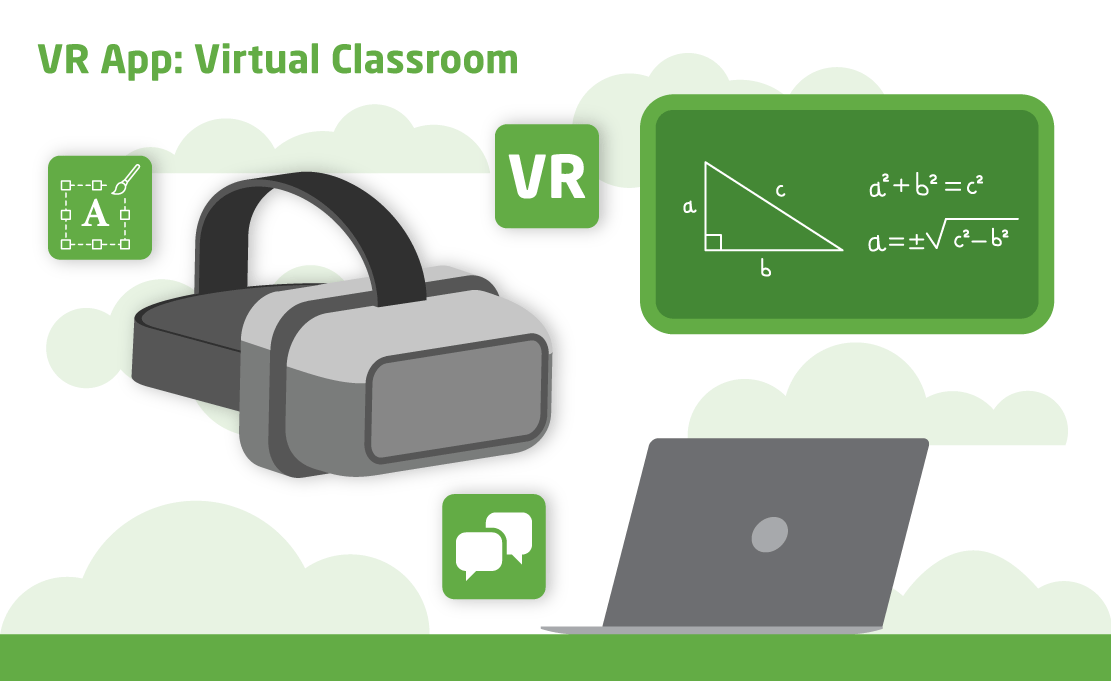The augmented reality classroom is an application to transform the standard experience of attending lectures or remote learning through virtual lecture attendance. This solution allows you to participate in classes remotely, communicate with teachers and classmates, and interact with them in a virtual environment. The application allows you to simulate the atmosphere and a real learning experience, making it more interesting and engaging for students, as well as increasing lecture attendance.
Main project goals:
- Create a virtual classroom with classroom attributes and all necessary items
- Ability to choose the type of learning space (lecture hall, chemistry laboratory, etc.)
- Ability to use the space for practical tasks and the ability to simulate practical exercises
- Providing students with the opportunity to experience the entire learning atmosphere while attending classes remotely
VR App: Virtual Classroom
The augmented reality classroom is an application to transform the standard experience of attending lectures or remote learning through virtual lecture attendance. This solution allows you to participate in classes remotely, communicate with teachers and classmates, and interact with them in a virtual environment. The application allows you to simulate the atmosphere and a real learning experience, making it more interesting and engaging for students, as well as increasing lecture attendance.
Main project goals:
- Create a virtual classroom with classroom attributes and all necessary items
- Ability to choose the type of learning space (lecture hall, chemistry laboratory, etc.)
- Ability to use the space for practical tasks and the ability to simulate practical exercises
- Providing students with the opportunity to experience the entire learning atmosphere while attending classes remotely
Business Challenge
With the growing demand for solutions that stimulate and facilitate distance learning, the customer company saw an opportunity in creating a new solution for universities. First of all, the main goal was to ensure that lectures and educational programs would be something more than just watching informative videos or communicating via video conferences. Traditional educational platforms that existed on the market lacked interactive elements to increase student engagement and the quality of the material learned.
Virtual classroom software covered the following needs:
- Student engagement. Traditional video lectures sometimes seem too boring to students, and the monotonous information is difficult to perceive.
- Practical options for conducting hands-on learning. Many areas of study at universities require practical experiments, research, and more, so having such an opportunity in the field of distance learning is a great advantage.
- Extension of the technical opportunities in comparison to the competitors. Existing competitor solutions offered advanced options such as lectures, quizzes, video lessons, etc. But the new virtual classroom solution allows you to fully immerse yourself in the learning atmosphere and attend classes.
- Giving an option for interactive learning in the remote mode. Students don’t always have access to expensive hardware, so we had to think about how to implement a solution for access from different devices.
Solution
The AR & VR development team created the virtual classroom solution with the following key features:
- Immersive virtual classrooms where students can enter a virtual 3D classroom, laboratory, lecture hall, and other spaces. The developed solution allows you to experience sounds, lights, and the presence of other students in real time. Students can walk around the classroom, sit in chairs, raise their hands, interact with whiteboards, holographic displays, and conduct experiments.
- Interactive learning tools that help engage students more in the process and provide practical knowledge. Examples include virtual laboratories for conducting experiments in subjects such as chemistry, physics, biology, and 3D simulations with the ability to explore and manipulate objects.
- Cross-device access to grant the access to all the students with different hardware combinations 1) Oculus gives a full effect of presence 2) Access mobile and tablets – the ability to use the application with augmented reality 3) Access via desktop app (Windows/macOS) access to the class from a 3rd person, where the process is controlled by clicking the mouse or keyboard 4) Web version.
- Analytics and reporting options. Analytics allows gaining insights into student engagement. It includes the following: tracking student engagement (duration of class time and interaction), heat mapping (class movement statistics for better lesson planning), and custom reports (e.g., attendance, etc.).
- Offline mode option. Students will have access to some modules, like lecture replays or similar.
Business Impact
The delivered virtual classroom software allowed the customer company to expand the range of products it offers for educational institutions. The company began offering this solution to universities and later began to incorporate it into the educational process. As a result, student lecture attendance increased by 45%, student grades improved due to better assimilation of the material, and students began to complete their practical assignments faster (according to information from the customer).
